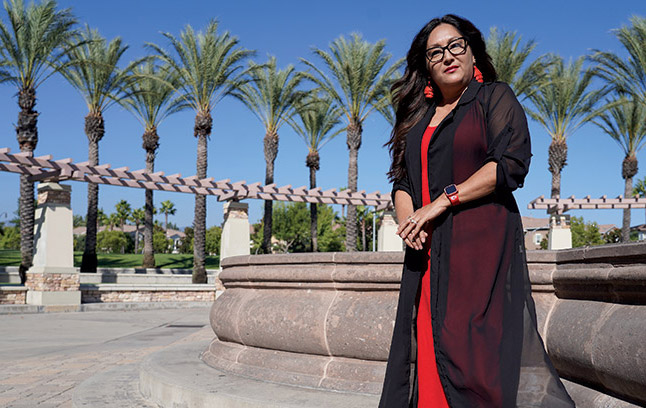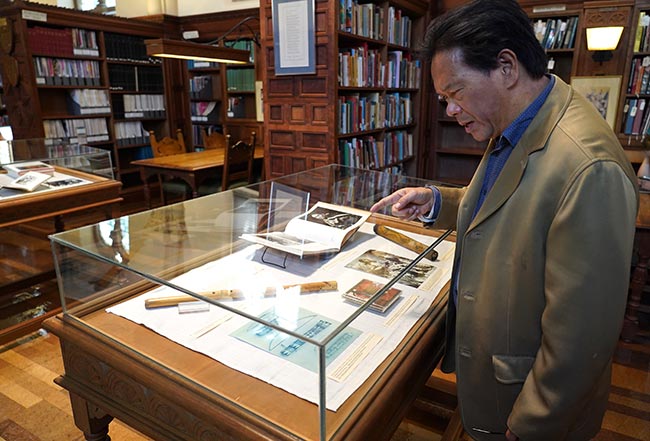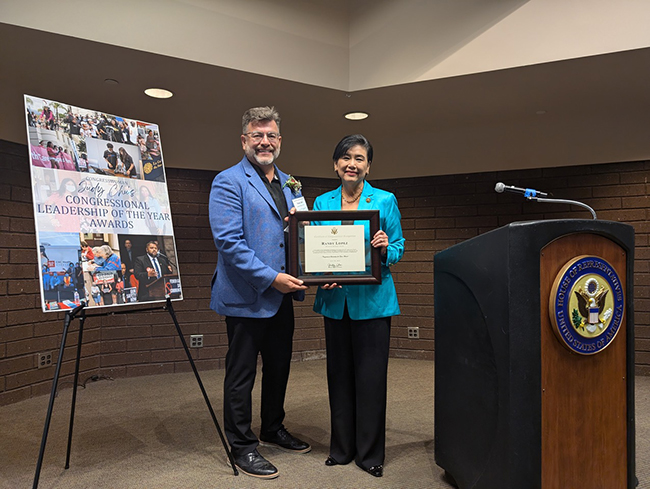‘They are still here’: Exhibit, performance highlight Indigenous peoples

by Andrew Alonzo | aalonzo@claremont-courier.com
Two years ago, father and son duo Hao and Micah Huang pitched an idea to the Gabrielino-Shoshone Nation of Southern California: share your stories with the Claremont community.
The idea’s nearly come full circle and is set to arrive October 7 in the form of a live performance titled “íyo’toróvim yaraarkokre ‘eyoo’ooxono (We the Caretakers Remember our Land),” sponsored by the West Covina-based Gabrielino-Shoshone Nation and Scripps Presents at 7 p.m. at Garrison Theater, 231 E. 10th St., Claremont. Free tickets are at eventbrite.com, search “Scripps Presents.”
Marcella Castrejon, Tribal Secretary of Education and Records for the Gabrielino-Shoshone Nation and the project’s executive director, said the performance is a music, art and language exhibition that emphasizes the stories of Indigenous professionals.

Marcella Castrejon is the Tribal Secretary of Education and Records for the Gabrielino-Shoshone Nation. Courier photo/Andrew Alonzo
“These are personal stories of indigenous people who came from being young and trying to figure out who they wanted to be and became very professional and are now giving back,” Castrejon said.
Three speakers are set to take the stage including social worker Donald Rodriguez, a Gabrielino-Shoshone member who will discuss the Indian Child Welfare Act, the rehoming of Indigenous children, and how the Gabrielino-Shoshone Nation works with Anahuacalmecac International Preparatory of North America, the only Indigenous, community-based kindergarten to 12th grade school in Los Angeles County; Natural History Museum wildlife biologist Miguel Ordeñana — the man who discovered the late mountain lion P-22 — will share the importance of land to wildlife; and songwriter, poet, and culture bearer Tina Calderon of Gabrielino-Tongva, Chumash and Yoeme descent will talk about music and her upbringing as a Native American. Castrejon’s uncle Nick Rocha, chair of the Gabrielino-Shoshone Tribal Council of Southern California, will close the performance. Rocha was present during a September 22 ceremony in Los Angeles which saw 12 acres of land returned to his tribe, the largest land restoration to an Indigenous tribe in the history of Los Angeles.
According to producer and composer Micah Huang, his music will add an “emotional substrate” often seen in cinema and will include strings, percussion, keyboards, and live electronics. “The music has to be able to adapt and change in response to the speakers’ words,” he wrote in an email. “It follows the structural paradigm of spontaneous or real-time composition as put forward by such artists as Arooj Aftab and Vijay Iyer.”
Castrejon hopes the performance invokes curiosity about Indigenous communities.
“There were villages there before Claremont became Claremont,” she said. “Why wouldn’t you want to know about who was there before you? You want to know what happened before you so you’re not there to repeat what happened. You don’t want someone else coming in and taking over what’s already there.”

Hao Huang, the Bessie and Cecil Frankel Endowed Chair in Music at Scripps College, with musical artifacts at Scripps College’s Ella Strong Denison Library. Courier photo/Andrew Alonzo
In addition, a new exhibit at Scripps College’s Denison Library that compliments the upcoming performance, “Remembering the Caretakers of the Land: Materials on Southern Californian and Southwest Native American Peoples,” opened Monday.
Hao Huang, the Bessie and Cecil Frankel Endowed Chair in Music at Scripps College, and Jennifer Martinez Wormser, the Denison Library director and the Sally Preston Swan Librarian, curated the exhibit. Housed in five glass cases, it features Indigenous watercolors, music, history of the construction of the San Gabriel Mission where Spanish conquistadors colonized Indigenous peoples, as well as photos and books on and by local Indigenous peoples.
“The most notable and unique items displayed are the two indigenous musical instruments, a Cahuilla flute and an Apache fiddle, loaned to us by our colleagues at the nearby Benton Museum of Art at Pomona College, as well as three original watercolor drawings by [Thomas/Tomas] Vigil, also known as Pan Yo Pin, which are part of the Hartley Burr Alexander Collection here at Denison Library,” Martinez Wormser wrote in an email. Literature came from Hao Huang and the Denison, while photographs by Edward Curtis were sourced online. View works by Vigil and others at ccdl.claremont.edu/digital.
“The overarching theme of the exhibition is the interconnectedness of indigenous peoples of Southern California and the Southwest through music and their shared Uto-Aztecan language roots,” read Martinez Wormser’s email. The dialects stretch as far north as Washington state, through California into east Mexico and further south to El Salvador.
“Linguistics now is really doing a job of recapturing history [and] pre-history,” Hao Huang added. “Even though we don’t have written down histories of what happened, we can start to follow these linguistic groups.”
The installation — running through October 14 at 1090 Columbia Ave., Claremont — is free and open to the public from 10 a.m. to 9 p.m. Monday to Wednesday; 10 a.m. to 4 p.m. Thursday and Friday; noon to 4 p.m. Saturday; and noon to 9 p.m. Sunday. More info is at scrippscollege.edu/denison.
With the Denison exhibit live and the Scripps show a week away, Martinez Wormser and Hao Huang invite locals to the library. “It provides a place beyond the performance where visitors can reflect on the intersection of music, storytelling, language and complex histories with respect to indigenous communities,” Martinez Wormser wrote.
Hao Huang added it’s important surrounding residents recognize the land underfoot and the history of dispossession, genocide and colonialism against the Native Americans on display at Denison. Huang and Castrejon also hope the projects reaffirm to all that Indigenous communities are alive.
“My hope is that they will also come away with a real appreciation of other people’s humanity,” Hao Huang said. “They are still here. They have their stories that need to be heard.”









0 Comments